2011 Week 7
With the cellar hole fully exposed, mapped, and photographed, this week we began to excavate part of it. .

Allison Conner, field assistant, Stephen Warner and Jerry Warner excavate the cellar hole.
For a feature like this, we string two lines across the length and width so that the feature is quartered. After the first quarter is excavated, we can begin profiles of the two walls which record both the stratigraphy of the fill and the original shape of the feature. As the upper layers were excavated, we immediately began to find things, including a large piece of tin glazed earthenware with blue decoration. .
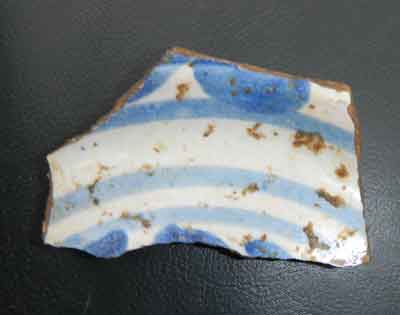
Part of a tin glazed earthenware plate recovered from the plaster fill in the cellar.
This was a truly beautiful object but it was the more prosaic tobacco pipes and other dateable materials that were the most interesting finds. They suggest that the upper fill in the cellar dates to the late 17th century, perhaps the last quarter of the century.
When first exposed a couple of weeks ago, we were uncertain if the white material in the fill was plaster, mortar or a combination of both. That question was definitely answered as all of the material is plaster, some of it with a glossy finish coat.
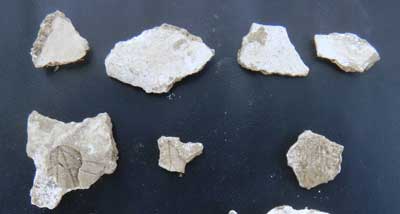
Examples of plaster from the cellar.
This material would not have been on the walls of an outbuilding and must have come from the Calvert House itself. Sometime late in the 17th century, one of the Ordinary keepers renovated part of the house and tore out this plaster. The cellar hole, already partially filled, was a convenient dumping spot. In the photo, the top row shows several pieces with the glossy finish coat. The first two pieces in the second row have what appear to be leaf impressions on the back side and the final piece has a good impression of the grain of the lath on which the plaster was applied.
Archaeologists always hope that when they dig a sealed feature, it will be full of trash, or to be scientific, artifacts. While there were some artifacts in the lower fill, they were not abundant. The cellar hole extended about 3.5 feet below the surface
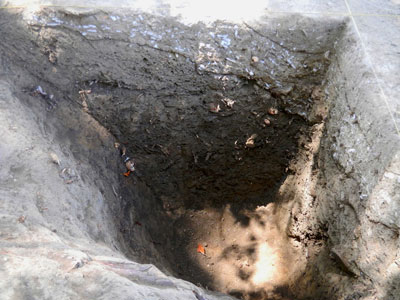
Profile of the west wall of the cellar.
In the photo, the plaster level is very obvious. Below it, the fill consists of one layer of a brown, sandy silt loam. Materials from this fill are much earlier than those in the plaster fill. Some of the most common artifacts in the lower fill were fragments of terra cotta pipes. These pipes are characteristic of the first half of the 17th century, perhaps extending up to the 1670s. In addition, the white clay pipe fragments have bore stem diameters that suggest a similar dating. One of these had a marker’s mark on the bottom of the heel.

Dutch pipe with a maker’s mark on the heel.
The central motif, looking like a T, is often suggested to be a tobacco plant and the maker’s initials are WW. Pipes like this are Dutch and have been found in archaeological contexts dating c. 1650-1660. Using all of this information, we can suggest the cellar was part of an early outbuilding that was filled in by mid-century. Over time, the fill slumped and the plaster fill was added later.
Work in the midden continued as well. Not to be outdone by those working in the cellar, excavators in the midden recovered a complete terra cotta pipe bowl.
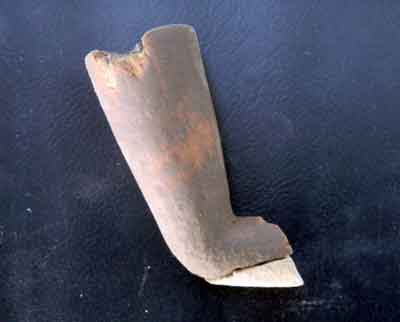
Complete terra cotta pipe bowl found in the Calvert House midden.
As mentioned earlier, terra cotta pipes are early at St. Mary’s City. While many were made by Native Americans, there is evidence from the ditch of Pope’s Fort, built around the Calvert House, that pipe making was being done by the colonists as well.
Testing beyond the reconstructed fence, west of the site, has not found any fence lines.
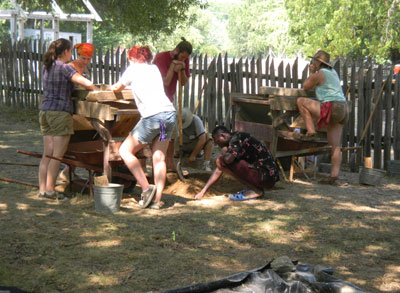
View of excavations west of the Calvert House.
In fact, the contrast between the deposits on either side of the fence is stark. Inside the fence, the soil is dark, organic and has large amounts of 17th-century debris. Outside the fence, the soils are light, hard packed and have very little from the 17th century. If this is an accurate distribution, then the fence was an incredibly potent boundary. However, oral history suggests that at some time in the past, the lawn on this side of the Brome-Howard House was graded. We have never fully identified this disturbance but it may account for a lack of 17th century material here. Arguing against this is a large amount of debris from other periods. There seems to be a lot of prehistoric material as well as 19th century artifacts here. Most surprisingly, there are a number of 18th-century ceramics, which are not common in other parts of the site. Resolution of this issue will need to wait for a full consideration of the overall artifact assemblage.


